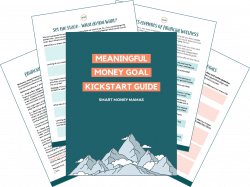Are you planning on setting money goals for 2020? Have you done the work to make sure that they are (a) the right goals for you and (b) goals you can stay motivated about and actually achieve?
All too often, we try to set money goals in a vacuum. We pay attention to what we “should” do or wait for a moment of complete money frustration to set goals that aren’t much more than knee jerk reactions to being disappointed with where we stand today. And those goals lack MEANING.
To set meaningful financial goals you can actually achieve, you first have to do the work to determine what you really want.
1 – Consider the Relationship You Want With Money
We can continue to try to pretend that money is just a matter of simple math. Dollars and cents. Spend less than you make, invest for the future. Easy peasy.
But we all know, in our heart of hearts, that there is more to it than that.
Money impacts every area of our lives. Where we live, the work we do, where our kids go to school, the cars we drive, the food we eat. Everything. And those constant interactions with money create an emotional relationship – positive or negative – over time.
The actions we take with money are driven by emotion. We set goals, spend money, start arguments about the budget with our spouse because we want to feel a certain way.
For instance, we don’t want to get out of debt just because it saves us money. We want it because it makes us feel secure or independent or free.
But when we haven’t evaluated how we do want to feel and the relationship we want with money, the decisions we make in the short-term could bring us further away from our real goal.
So, before setting goals, ask yourself how you really want to feel about money.
Secure, content, and abundant are some options. But you may want to feel focused, influential, nurtured, or endless different emotions.
Once you identify how you want to feel, think about what actions or situations in your financial life would bring you closer to that emotion. Consider both activities you could do today or with very little money and longer-term situations. Then, keep that list nearby. It’s your first indication of your priorities with money.
Interested in getting clearer on your ideal relationship with money? Click here access the ‘How Do You Want to Feel About Money?’ module (video and worksheets) of our How to Set Life-Changing Financial Goals course for FREE.
2 – Identify Your Core Values
At first glance, your core values might seem similar to your core desired feelings about money. But your core values are things you value most in life. Family, education, travel, good food – you name it.
Your goals and your long-term vision should reflect your core values. Ideally, you’re moving towards a life where you live more in alignment with those things.
But here’s the beautiful thing – you don’t need to be wealthy or debt-free to build your values into your life.
Sometimes, we convince ourselves that we simply can’t have the things we want. We box ourselves into scarcity. Or force deprivation as punishment for not being where we want to be in life.
In reality, though, there are ways to express your values at all different levels of wealth. You may value travel and family and dream of taking your kids around the world. But if you aren’t there yet, you still have options. Set a night of the week where you all cook a recipe together from a different country. Watch foreign movies together. Learn a language.
You’re in can make choices that joyful and bring you closer to what matters to you.
Before setting goals, identify your values and define what that looks like for you.
What does living in alignment with your values look like in an ideal world? What are free, low-cost, and moderate-cost ways to build those values into your life as you pursue your dream life?
This list is going to be your lifeline to finding joy and contentment no matter where you are in your financial journey. You can use it to remind yourself that choosing to budget or prioritize your money for the long-term doesn’t mean you can’t live a life you love today.
3 – Review Your Current Money Situation
You can’t set financial goals without knowing where you stand today. This step in the process is hard for so many people. They’ve been avoiding their finances for so long – hoping it just resolves itself – that they’re afraid to look.
But you and I both know you can’t create a solid plan for your money without knowing where you’re starting.
Before you take what you’ve learned about your desired relationship with money and core values and create some goals, here are a few ways to check in on your financial situation.
- Review your last few months’ spending. How much money do you spend and where? Do you spend more than you make or less? Are there areas of your spending that surprised you? Take the time to consider whether each budget category aligns with your values.
- Calculate your net worth. How much do you have in assets? Do you know how much you have in debt? Your net worth is a great overarching view of your financial health. And a good way to know if you’re on pace for big long-term goals like buying a house or retirement.
- Set a bare-bones budget. Many people fail to achieve their money goals because they look at their current spending and then try to identify places to cut. When you do it that way, everything feels essential. Instead, take out a clean sheet of paper and build your spending plan from the bottom up. Cover essential needs like housing, the minimum you could spend on food, utilities, ect. Then build your long-term vision and goals off of that base frame, choosing to add back they “luxury” expenses that bring you the most joy and are most in alignment with your values.
- Know where you have holes in your financial boat. Are you saving enough for retirement? Do you have an emergency fund? No guru can tell you exactly what your goals should be. That depends on you. But there are common elements of financial health you want to be sure you’re building into your plan. (You can find the 10 Elements of Financial Wellness in our free Meaningful Money Goals Kickstart Guide)
By reviewing where you stand today, you’ll know how much disposable income you have to really throw at your goals. You’ll find places where your expenses reflect someone else’s values, not your own. But most of all, you’ll know where you’re starting.
4 – Create Your Long-Term Vision
With your values in hand, take a some time to dream. What would your ideal life look like? How would you most like to express your values? How would you be handling money?
But instead of stopping at the, “I want to be retired early, swinging on a hammock on the beach,” dig deeper. Once you got the rest you needed from the hustle you feel today, how would you spend your days? What would an ideal week look like?
Make your vision real in your mind. Then, do some research.
For so many people, your dream life is more achievable than you think. Often, what you think your dream life would cost is 5 to 10 times what it would actually cost. By doing some digging and mapping things out specifically, you’ll know exactly what you have to shoot for.
Set Short-, Medium-, and Long-Term Goals
Now, you’re ready to set goals with meaning. You know the relationship you want with money, your core feelings, you have a clear picture of the life you want, and you know where you’re starting. All the pieces are in place.
The final step is to break that vision into specific, achievable short-, medium- and long-term goals.
If you know where you want to be in 10 years, where do you have to be in 5 years to be on track? What milestones will get you to your 5-year goal? And where can you start today to achieve the first milestone?
Make your goals specific and measurable. Create a plan to check in on your progress regularly so you remember what you’re shooting for.
And don’t forget to include activities and behaviors that align with your values, even when you’re early in your journey. When you feel contented and fulfilled along the way, you’re more likely to stick to your big goals.
Embrace Your Goals & Find The Support You Need
Doing the work to set meaningful goals might seem like a waste of time when you could just scribble “I want to get out of debt” on a sticky note and get started. But I promise you that having concrete, grounded goals will make it easier to change your behaviors and get where you want to go long-term. You’ll feel empowered by the changes your making.
Yet, being connected to your goals won’t make the journey easy. Life will always throw us unexpected ups and downs. So, find friends who will encourage and support you along the way. Join the Mamas Talk Money Facebook community. Create ways to keep your goals and vision front and center.
But most of all? Give yourself grace. Improving your finances and building the life you want is a process. Celebrate every little bit of progress. And know that you’ve got this.
We’re cheering for you, mama!
What are your big financial goals? How are you getting there? Drop a note in the comments to share with other moms in our community!





I just reviewed the cold hard facts from last month to see where we can start moving the needle. I suspect I need to increase my inflow without turning into a momzombie. . . that doesn’t happen overnight but I’m ready to find a path.